MA511 Financial Accounting & Reporting: Australian Standards
VerifiedAdded on 2023/01/07
|8
|1656
|73
Report
AI Summary
This report examines financial reporting practices within Australia, focusing on the requirements and influences shaping financial statements. It begins by identifying key sources of financial reporting regulations, including the Corporations Act, Australian Accounting Standards (AASB), and the Conceptual Framework. The report then analyzes arguments for and against disclosure regulations, evaluating their impact on accountability and decision-making. It explores the influence of the IASB on Australian financial reporting, detailing the adoption of IFRS and the role of AASB. The nature of reporting entities and the entities subject to accounting standards are clarified, along with the objectives of General Purpose Financial Reporting (GPFR) as defined by the Conceptual Framework. Furthermore, the report describes the purpose of the Conceptual Framework, including its role in developing and reviewing accounting standards. Finally, the report outlines the major changes in financial reporting practices, particularly the adoption of international reporting standards and the Accounting Conceptual Framework, highlighting the drivers for these changes, such as increased comparability and investor information.
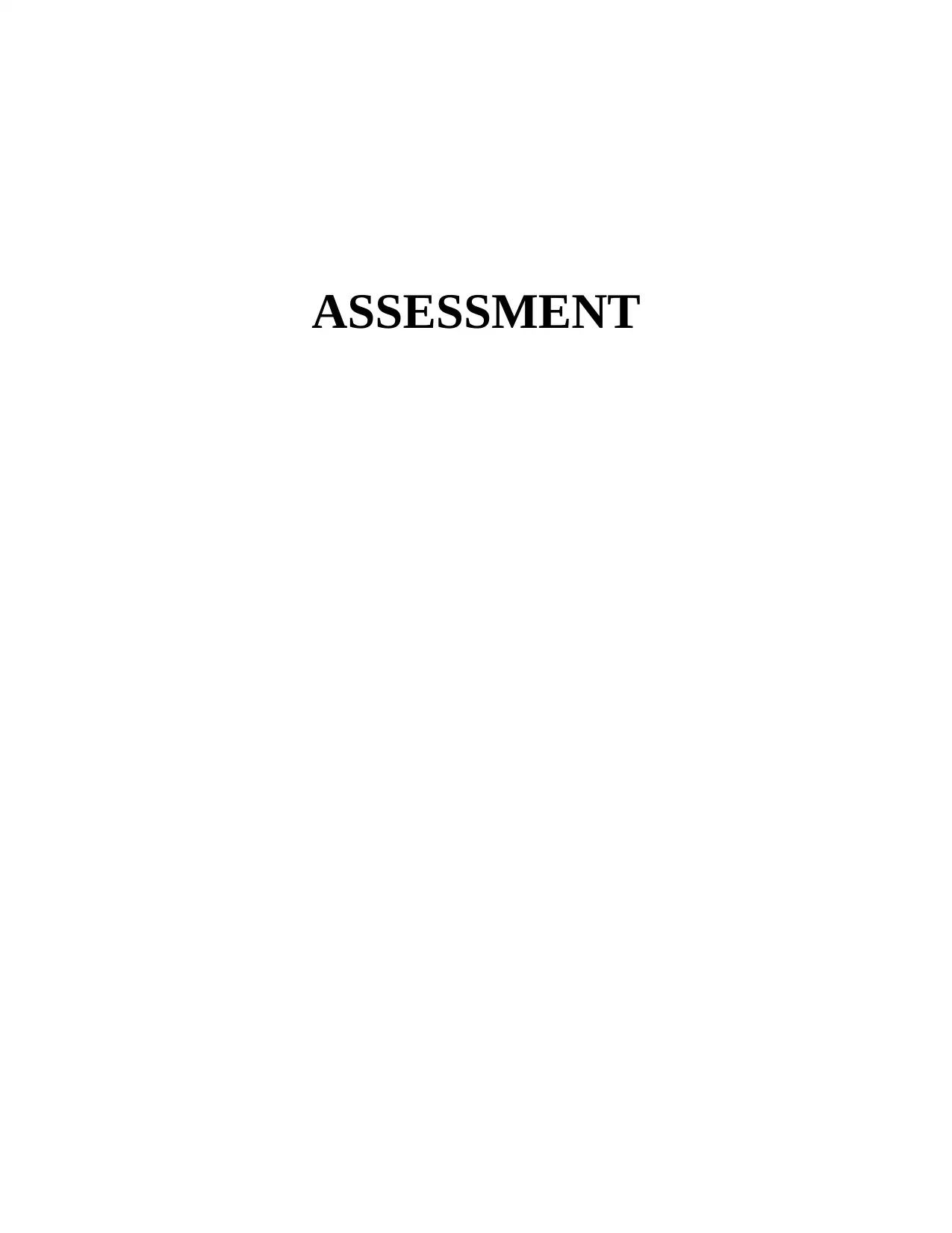
ASSESSMENT
Paraphrase This Document
Need a fresh take? Get an instant paraphrase of this document with our AI Paraphraser
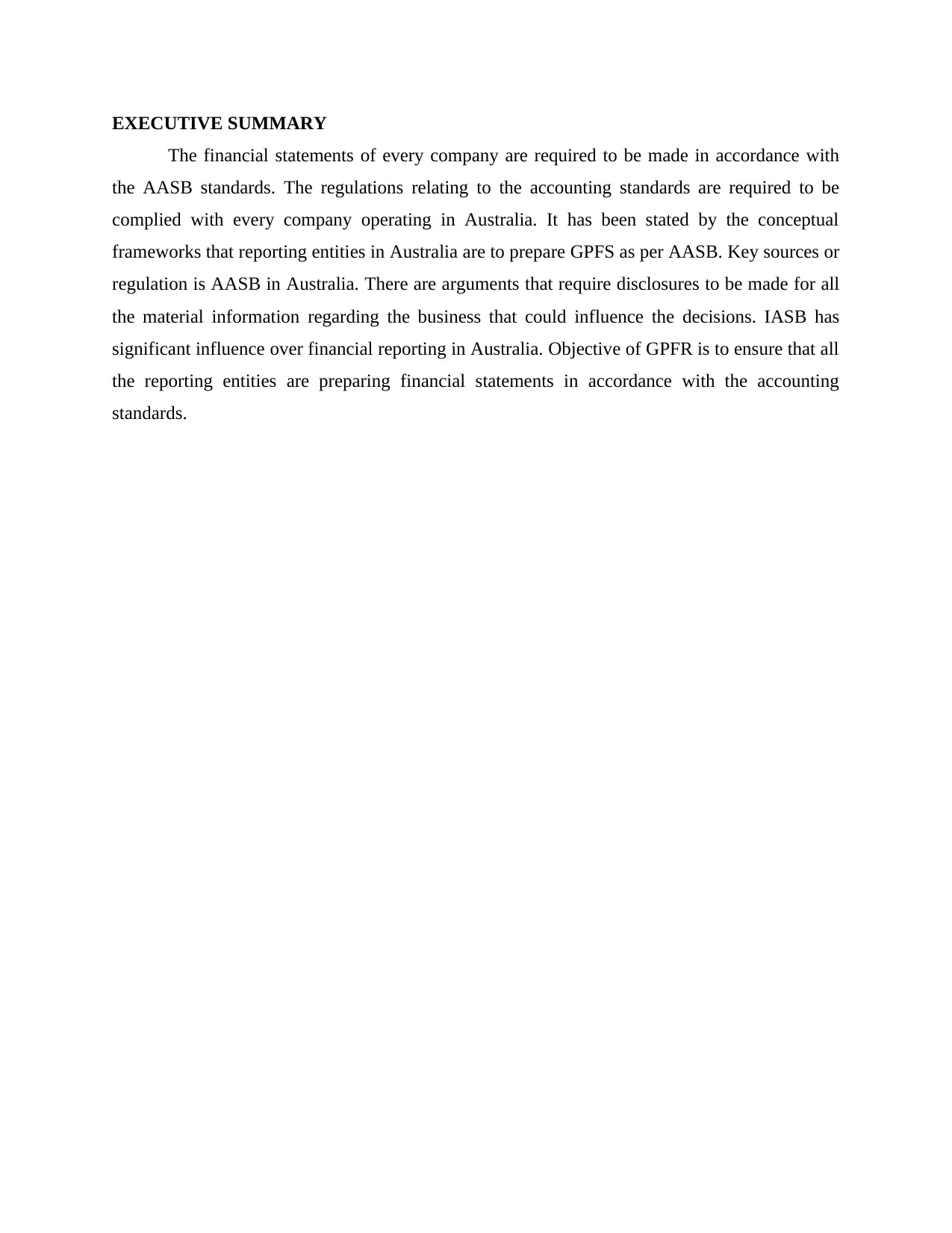
EXECUTIVE SUMMARY
The financial statements of every company are required to be made in accordance with
the AASB standards. The regulations relating to the accounting standards are required to be
complied with every company operating in Australia. It has been stated by the conceptual
frameworks that reporting entities in Australia are to prepare GPFS as per AASB. Key sources or
regulation is AASB in Australia. There are arguments that require disclosures to be made for all
the material information regarding the business that could influence the decisions. IASB has
significant influence over financial reporting in Australia. Objective of GPFR is to ensure that all
the reporting entities are preparing financial statements in accordance with the accounting
standards.
The financial statements of every company are required to be made in accordance with
the AASB standards. The regulations relating to the accounting standards are required to be
complied with every company operating in Australia. It has been stated by the conceptual
frameworks that reporting entities in Australia are to prepare GPFS as per AASB. Key sources or
regulation is AASB in Australia. There are arguments that require disclosures to be made for all
the material information regarding the business that could influence the decisions. IASB has
significant influence over financial reporting in Australia. Objective of GPFR is to ensure that all
the reporting entities are preparing financial statements in accordance with the accounting
standards.
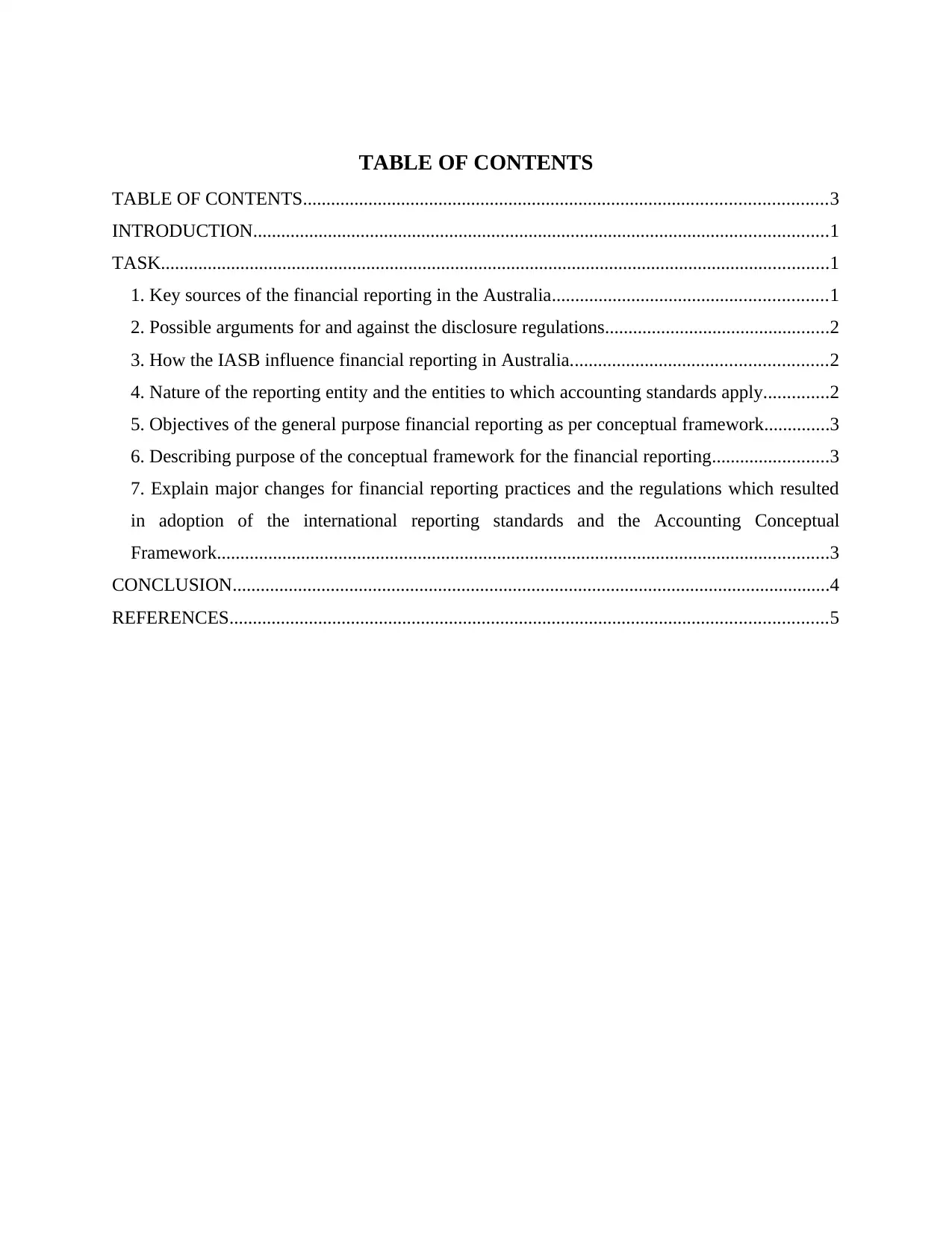
TABLE OF CONTENTS
TABLE OF CONTENTS................................................................................................................3
INTRODUCTION...........................................................................................................................1
TASK...............................................................................................................................................1
1. Key sources of the financial reporting in the Australia...........................................................1
2. Possible arguments for and against the disclosure regulations................................................2
3. How the IASB influence financial reporting in Australia.......................................................2
4. Nature of the reporting entity and the entities to which accounting standards apply..............2
5. Objectives of the general purpose financial reporting as per conceptual framework..............3
6. Describing purpose of the conceptual framework for the financial reporting.........................3
7. Explain major changes for financial reporting practices and the regulations which resulted
in adoption of the international reporting standards and the Accounting Conceptual
Framework...................................................................................................................................3
CONCLUSION................................................................................................................................4
REFERENCES................................................................................................................................5
TABLE OF CONTENTS................................................................................................................3
INTRODUCTION...........................................................................................................................1
TASK...............................................................................................................................................1
1. Key sources of the financial reporting in the Australia...........................................................1
2. Possible arguments for and against the disclosure regulations................................................2
3. How the IASB influence financial reporting in Australia.......................................................2
4. Nature of the reporting entity and the entities to which accounting standards apply..............2
5. Objectives of the general purpose financial reporting as per conceptual framework..............3
6. Describing purpose of the conceptual framework for the financial reporting.........................3
7. Explain major changes for financial reporting practices and the regulations which resulted
in adoption of the international reporting standards and the Accounting Conceptual
Framework...................................................................................................................................3
CONCLUSION................................................................................................................................4
REFERENCES................................................................................................................................5
⊘ This is a preview!⊘
Do you want full access?
Subscribe today to unlock all pages.

Trusted by 1+ million students worldwide
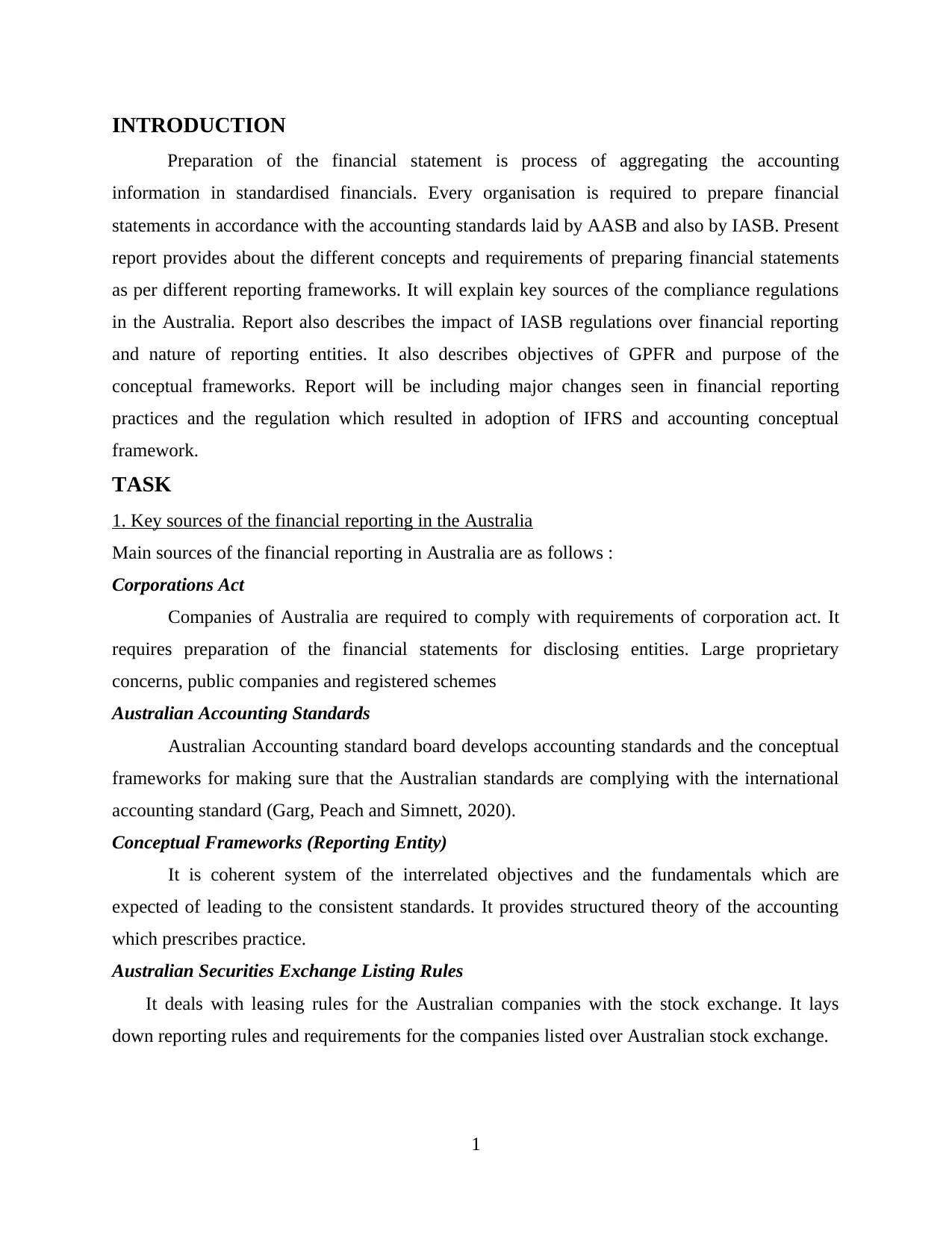
INTRODUCTION
Preparation of the financial statement is process of aggregating the accounting
information in standardised financials. Every organisation is required to prepare financial
statements in accordance with the accounting standards laid by AASB and also by IASB. Present
report provides about the different concepts and requirements of preparing financial statements
as per different reporting frameworks. It will explain key sources of the compliance regulations
in the Australia. Report also describes the impact of IASB regulations over financial reporting
and nature of reporting entities. It also describes objectives of GPFR and purpose of the
conceptual frameworks. Report will be including major changes seen in financial reporting
practices and the regulation which resulted in adoption of IFRS and accounting conceptual
framework.
TASK
1. Key sources of the financial reporting in the Australia
Main sources of the financial reporting in Australia are as follows :
Corporations Act
Companies of Australia are required to comply with requirements of corporation act. It
requires preparation of the financial statements for disclosing entities. Large proprietary
concerns, public companies and registered schemes
Australian Accounting Standards
Australian Accounting standard board develops accounting standards and the conceptual
frameworks for making sure that the Australian standards are complying with the international
accounting standard (Garg, Peach and Simnett, 2020).
Conceptual Frameworks (Reporting Entity)
It is coherent system of the interrelated objectives and the fundamentals which are
expected of leading to the consistent standards. It provides structured theory of the accounting
which prescribes practice.
Australian Securities Exchange Listing Rules
It deals with leasing rules for the Australian companies with the stock exchange. It lays
down reporting rules and requirements for the companies listed over Australian stock exchange.
1
Preparation of the financial statement is process of aggregating the accounting
information in standardised financials. Every organisation is required to prepare financial
statements in accordance with the accounting standards laid by AASB and also by IASB. Present
report provides about the different concepts and requirements of preparing financial statements
as per different reporting frameworks. It will explain key sources of the compliance regulations
in the Australia. Report also describes the impact of IASB regulations over financial reporting
and nature of reporting entities. It also describes objectives of GPFR and purpose of the
conceptual frameworks. Report will be including major changes seen in financial reporting
practices and the regulation which resulted in adoption of IFRS and accounting conceptual
framework.
TASK
1. Key sources of the financial reporting in the Australia
Main sources of the financial reporting in Australia are as follows :
Corporations Act
Companies of Australia are required to comply with requirements of corporation act. It
requires preparation of the financial statements for disclosing entities. Large proprietary
concerns, public companies and registered schemes
Australian Accounting Standards
Australian Accounting standard board develops accounting standards and the conceptual
frameworks for making sure that the Australian standards are complying with the international
accounting standard (Garg, Peach and Simnett, 2020).
Conceptual Frameworks (Reporting Entity)
It is coherent system of the interrelated objectives and the fundamentals which are
expected of leading to the consistent standards. It provides structured theory of the accounting
which prescribes practice.
Australian Securities Exchange Listing Rules
It deals with leasing rules for the Australian companies with the stock exchange. It lays
down reporting rules and requirements for the companies listed over Australian stock exchange.
1
Paraphrase This Document
Need a fresh take? Get an instant paraphrase of this document with our AI Paraphraser
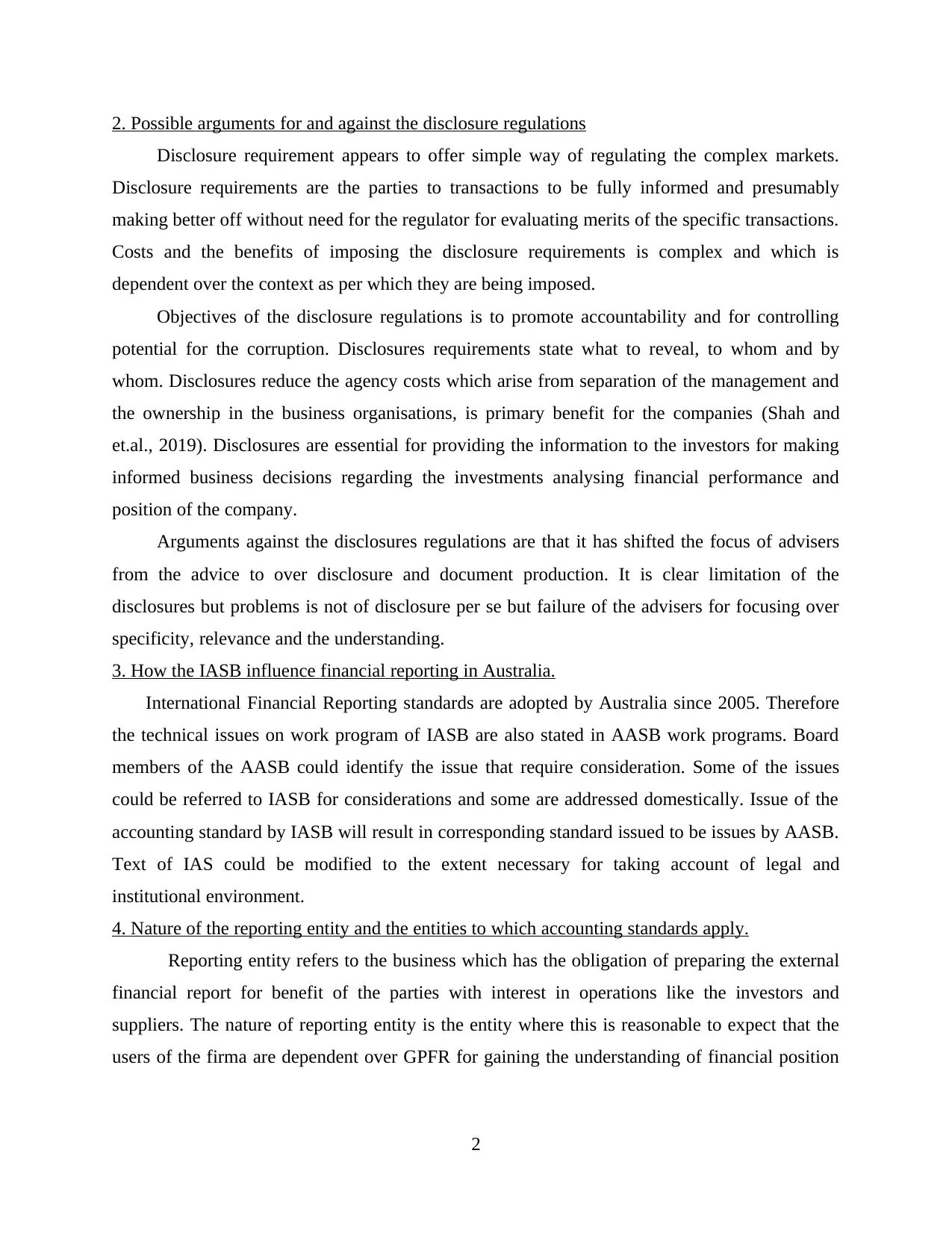
2. Possible arguments for and against the disclosure regulations
Disclosure requirement appears to offer simple way of regulating the complex markets.
Disclosure requirements are the parties to transactions to be fully informed and presumably
making better off without need for the regulator for evaluating merits of the specific transactions.
Costs and the benefits of imposing the disclosure requirements is complex and which is
dependent over the context as per which they are being imposed.
Objectives of the disclosure regulations is to promote accountability and for controlling
potential for the corruption. Disclosures requirements state what to reveal, to whom and by
whom. Disclosures reduce the agency costs which arise from separation of the management and
the ownership in the business organisations, is primary benefit for the companies (Shah and
et.al., 2019). Disclosures are essential for providing the information to the investors for making
informed business decisions regarding the investments analysing financial performance and
position of the company.
Arguments against the disclosures regulations are that it has shifted the focus of advisers
from the advice to over disclosure and document production. It is clear limitation of the
disclosures but problems is not of disclosure per se but failure of the advisers for focusing over
specificity, relevance and the understanding.
3. How the IASB influence financial reporting in Australia.
International Financial Reporting standards are adopted by Australia since 2005. Therefore
the technical issues on work program of IASB are also stated in AASB work programs. Board
members of the AASB could identify the issue that require consideration. Some of the issues
could be referred to IASB for considerations and some are addressed domestically. Issue of the
accounting standard by IASB will result in corresponding standard issued to be issues by AASB.
Text of IAS could be modified to the extent necessary for taking account of legal and
institutional environment.
4. Nature of the reporting entity and the entities to which accounting standards apply.
Reporting entity refers to the business which has the obligation of preparing the external
financial report for benefit of the parties with interest in operations like the investors and
suppliers. The nature of reporting entity is the entity where this is reasonable to expect that the
users of the firma are dependent over GPFR for gaining the understanding of financial position
2
Disclosure requirement appears to offer simple way of regulating the complex markets.
Disclosure requirements are the parties to transactions to be fully informed and presumably
making better off without need for the regulator for evaluating merits of the specific transactions.
Costs and the benefits of imposing the disclosure requirements is complex and which is
dependent over the context as per which they are being imposed.
Objectives of the disclosure regulations is to promote accountability and for controlling
potential for the corruption. Disclosures requirements state what to reveal, to whom and by
whom. Disclosures reduce the agency costs which arise from separation of the management and
the ownership in the business organisations, is primary benefit for the companies (Shah and
et.al., 2019). Disclosures are essential for providing the information to the investors for making
informed business decisions regarding the investments analysing financial performance and
position of the company.
Arguments against the disclosures regulations are that it has shifted the focus of advisers
from the advice to over disclosure and document production. It is clear limitation of the
disclosures but problems is not of disclosure per se but failure of the advisers for focusing over
specificity, relevance and the understanding.
3. How the IASB influence financial reporting in Australia.
International Financial Reporting standards are adopted by Australia since 2005. Therefore
the technical issues on work program of IASB are also stated in AASB work programs. Board
members of the AASB could identify the issue that require consideration. Some of the issues
could be referred to IASB for considerations and some are addressed domestically. Issue of the
accounting standard by IASB will result in corresponding standard issued to be issues by AASB.
Text of IAS could be modified to the extent necessary for taking account of legal and
institutional environment.
4. Nature of the reporting entity and the entities to which accounting standards apply.
Reporting entity refers to the business which has the obligation of preparing the external
financial report for benefit of the parties with interest in operations like the investors and
suppliers. The nature of reporting entity is the entity where this is reasonable to expect that the
users of the firma are dependent over GPFR for gaining the understanding of financial position
2
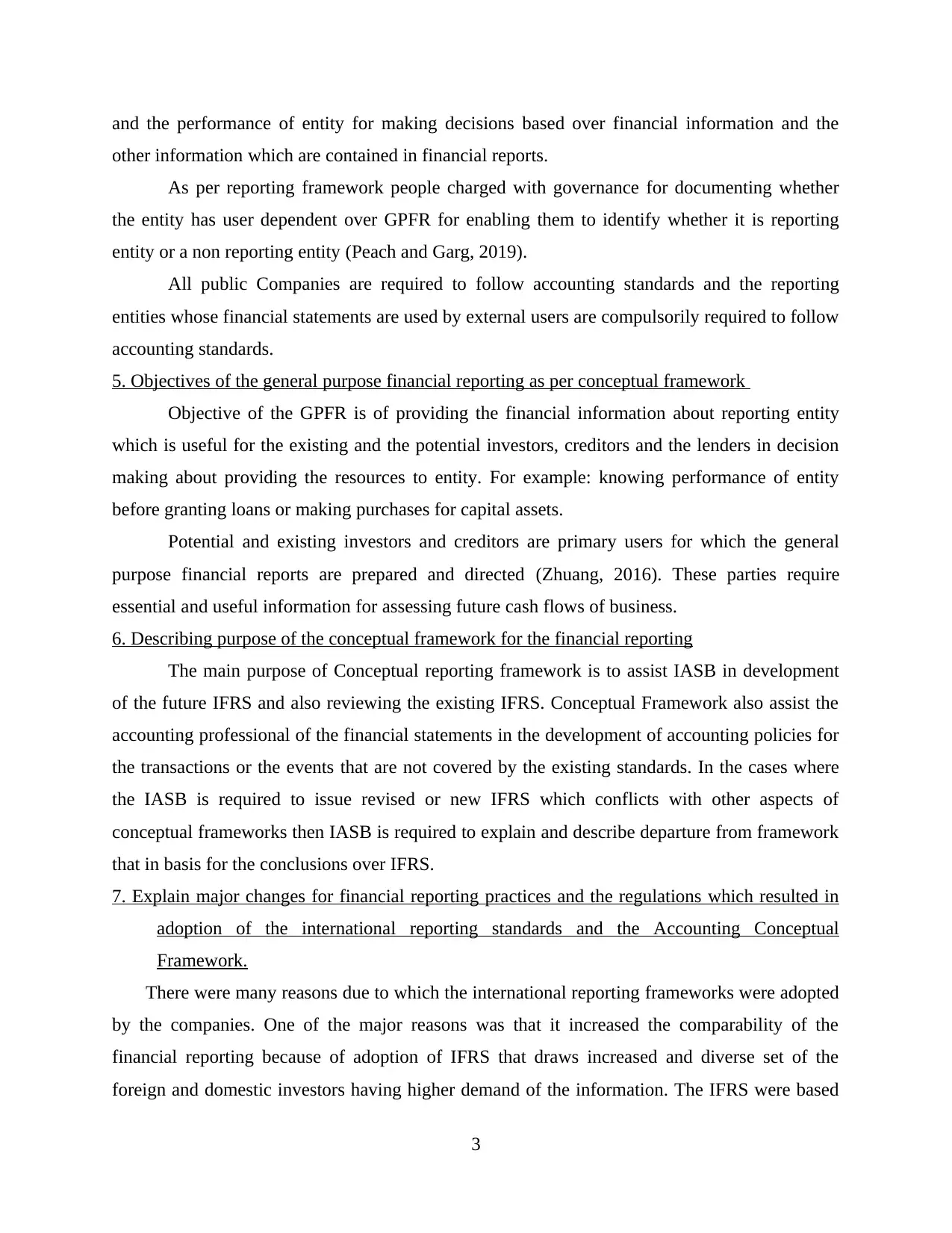
and the performance of entity for making decisions based over financial information and the
other information which are contained in financial reports.
As per reporting framework people charged with governance for documenting whether
the entity has user dependent over GPFR for enabling them to identify whether it is reporting
entity or a non reporting entity (Peach and Garg, 2019).
All public Companies are required to follow accounting standards and the reporting
entities whose financial statements are used by external users are compulsorily required to follow
accounting standards.
5. Objectives of the general purpose financial reporting as per conceptual framework
Objective of the GPFR is of providing the financial information about reporting entity
which is useful for the existing and the potential investors, creditors and the lenders in decision
making about providing the resources to entity. For example: knowing performance of entity
before granting loans or making purchases for capital assets.
Potential and existing investors and creditors are primary users for which the general
purpose financial reports are prepared and directed (Zhuang, 2016). These parties require
essential and useful information for assessing future cash flows of business.
6. Describing purpose of the conceptual framework for the financial reporting
The main purpose of Conceptual reporting framework is to assist IASB in development
of the future IFRS and also reviewing the existing IFRS. Conceptual Framework also assist the
accounting professional of the financial statements in the development of accounting policies for
the transactions or the events that are not covered by the existing standards. In the cases where
the IASB is required to issue revised or new IFRS which conflicts with other aspects of
conceptual frameworks then IASB is required to explain and describe departure from framework
that in basis for the conclusions over IFRS.
7. Explain major changes for financial reporting practices and the regulations which resulted in
adoption of the international reporting standards and the Accounting Conceptual
Framework.
There were many reasons due to which the international reporting frameworks were adopted
by the companies. One of the major reasons was that it increased the comparability of the
financial reporting because of adoption of IFRS that draws increased and diverse set of the
foreign and domestic investors having higher demand of the information. The IFRS were based
3
other information which are contained in financial reports.
As per reporting framework people charged with governance for documenting whether
the entity has user dependent over GPFR for enabling them to identify whether it is reporting
entity or a non reporting entity (Peach and Garg, 2019).
All public Companies are required to follow accounting standards and the reporting
entities whose financial statements are used by external users are compulsorily required to follow
accounting standards.
5. Objectives of the general purpose financial reporting as per conceptual framework
Objective of the GPFR is of providing the financial information about reporting entity
which is useful for the existing and the potential investors, creditors and the lenders in decision
making about providing the resources to entity. For example: knowing performance of entity
before granting loans or making purchases for capital assets.
Potential and existing investors and creditors are primary users for which the general
purpose financial reports are prepared and directed (Zhuang, 2016). These parties require
essential and useful information for assessing future cash flows of business.
6. Describing purpose of the conceptual framework for the financial reporting
The main purpose of Conceptual reporting framework is to assist IASB in development
of the future IFRS and also reviewing the existing IFRS. Conceptual Framework also assist the
accounting professional of the financial statements in the development of accounting policies for
the transactions or the events that are not covered by the existing standards. In the cases where
the IASB is required to issue revised or new IFRS which conflicts with other aspects of
conceptual frameworks then IASB is required to explain and describe departure from framework
that in basis for the conclusions over IFRS.
7. Explain major changes for financial reporting practices and the regulations which resulted in
adoption of the international reporting standards and the Accounting Conceptual
Framework.
There were many reasons due to which the international reporting frameworks were adopted
by the companies. One of the major reasons was that it increased the comparability of the
financial reporting because of adoption of IFRS that draws increased and diverse set of the
foreign and domestic investors having higher demand of the information. The IFRS were based
3
⊘ This is a preview!⊘
Do you want full access?
Subscribe today to unlock all pages.

Trusted by 1+ million students worldwide
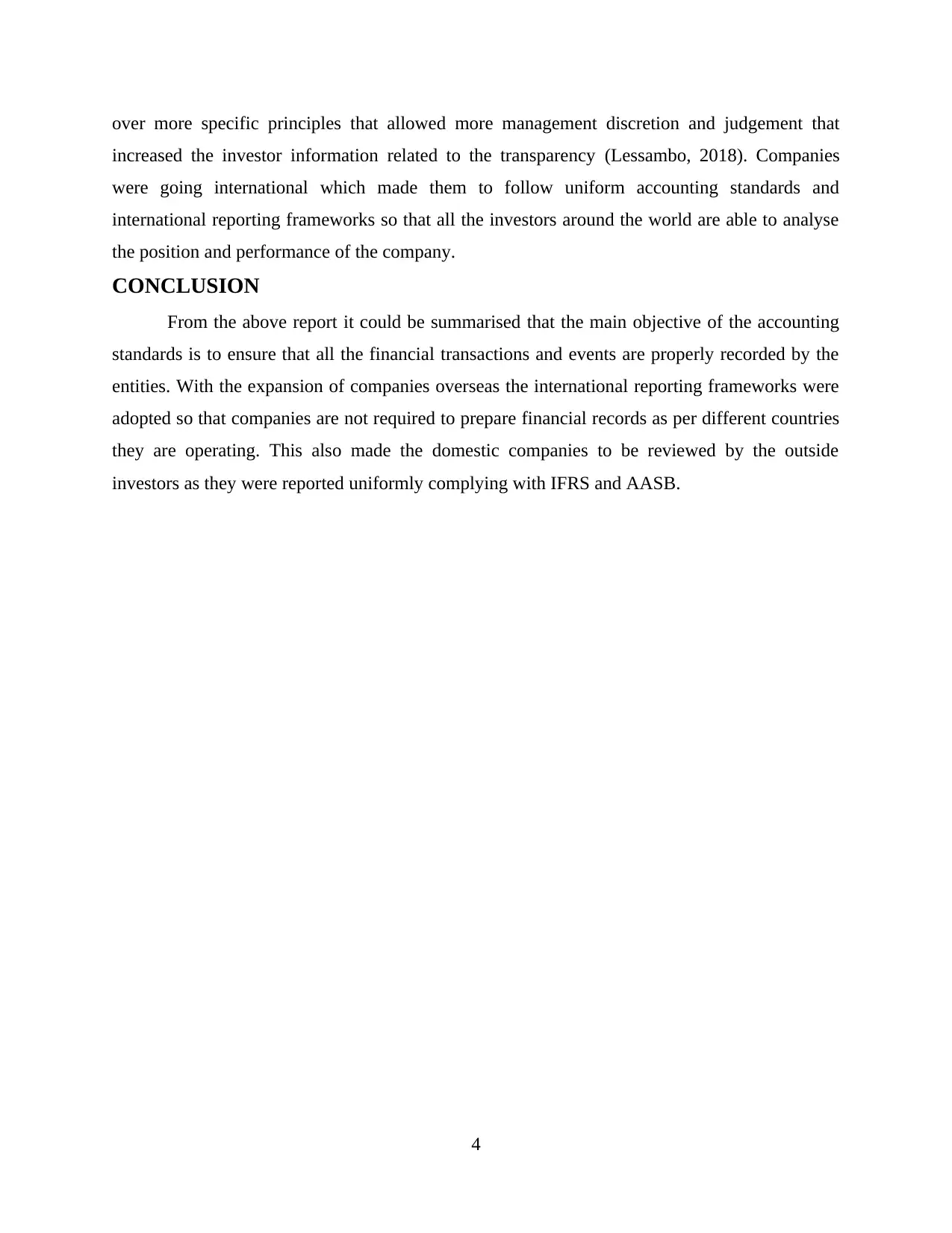
over more specific principles that allowed more management discretion and judgement that
increased the investor information related to the transparency (Lessambo, 2018). Companies
were going international which made them to follow uniform accounting standards and
international reporting frameworks so that all the investors around the world are able to analyse
the position and performance of the company.
CONCLUSION
From the above report it could be summarised that the main objective of the accounting
standards is to ensure that all the financial transactions and events are properly recorded by the
entities. With the expansion of companies overseas the international reporting frameworks were
adopted so that companies are not required to prepare financial records as per different countries
they are operating. This also made the domestic companies to be reviewed by the outside
investors as they were reported uniformly complying with IFRS and AASB.
4
increased the investor information related to the transparency (Lessambo, 2018). Companies
were going international which made them to follow uniform accounting standards and
international reporting frameworks so that all the investors around the world are able to analyse
the position and performance of the company.
CONCLUSION
From the above report it could be summarised that the main objective of the accounting
standards is to ensure that all the financial transactions and events are properly recorded by the
entities. With the expansion of companies overseas the international reporting frameworks were
adopted so that companies are not required to prepare financial records as per different countries
they are operating. This also made the domestic companies to be reviewed by the outside
investors as they were reported uniformly complying with IFRS and AASB.
4
Paraphrase This Document
Need a fresh take? Get an instant paraphrase of this document with our AI Paraphraser
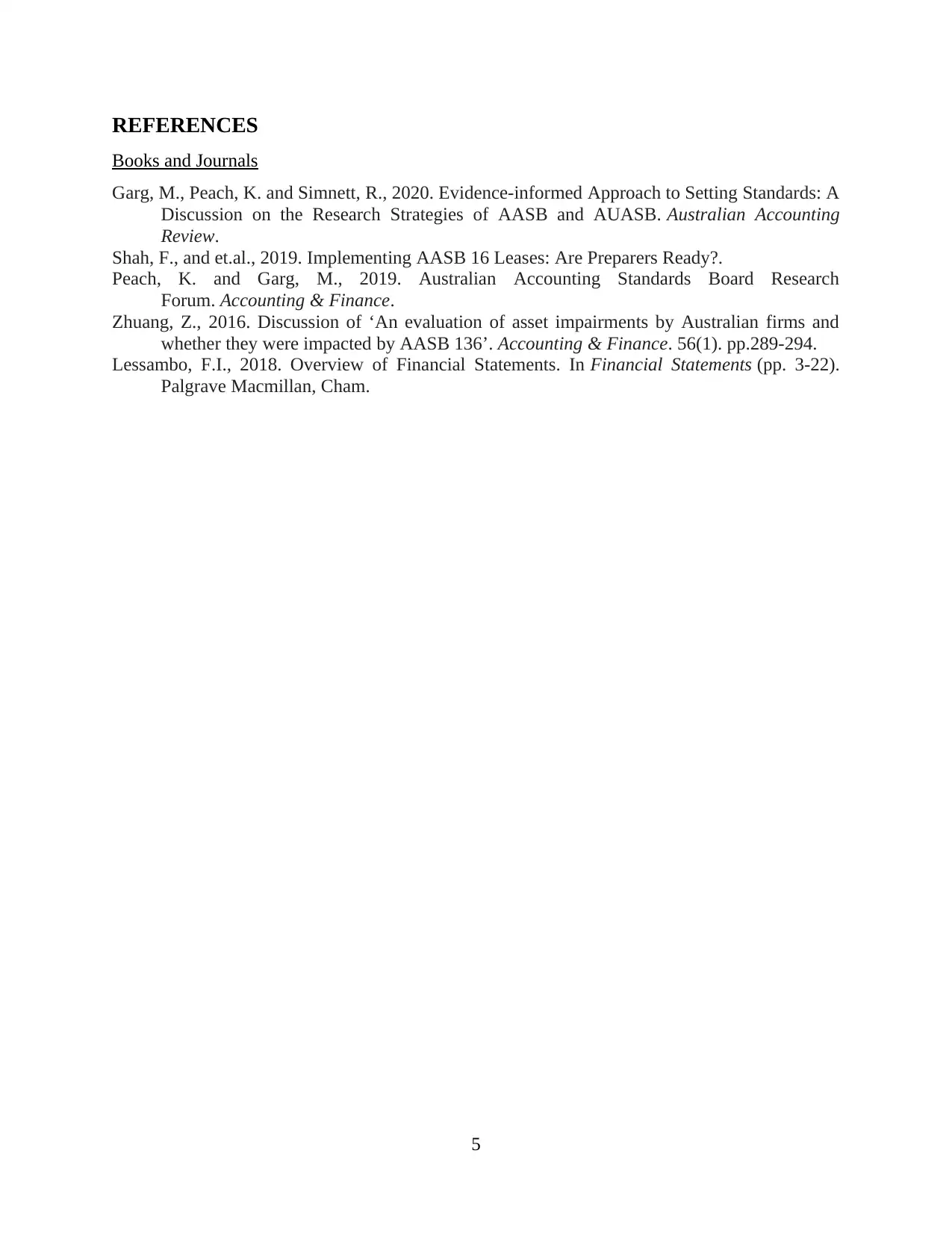
REFERENCES
Books and Journals
Garg, M., Peach, K. and Simnett, R., 2020. Evidence‐informed Approach to Setting Standards: A
Discussion on the Research Strategies of AASB and AUASB. Australian Accounting
Review.
Shah, F., and et.al., 2019. Implementing AASB 16 Leases: Are Preparers Ready?.
Peach, K. and Garg, M., 2019. Australian Accounting Standards Board Research
Forum. Accounting & Finance.
Zhuang, Z., 2016. Discussion of ‘An evaluation of asset impairments by Australian firms and
whether they were impacted by AASB 136’. Accounting & Finance. 56(1). pp.289-294.
Lessambo, F.I., 2018. Overview of Financial Statements. In Financial Statements (pp. 3-22).
Palgrave Macmillan, Cham.
5
Books and Journals
Garg, M., Peach, K. and Simnett, R., 2020. Evidence‐informed Approach to Setting Standards: A
Discussion on the Research Strategies of AASB and AUASB. Australian Accounting
Review.
Shah, F., and et.al., 2019. Implementing AASB 16 Leases: Are Preparers Ready?.
Peach, K. and Garg, M., 2019. Australian Accounting Standards Board Research
Forum. Accounting & Finance.
Zhuang, Z., 2016. Discussion of ‘An evaluation of asset impairments by Australian firms and
whether they were impacted by AASB 136’. Accounting & Finance. 56(1). pp.289-294.
Lessambo, F.I., 2018. Overview of Financial Statements. In Financial Statements (pp. 3-22).
Palgrave Macmillan, Cham.
5
1 out of 8
Related Documents
Your All-in-One AI-Powered Toolkit for Academic Success.
+13062052269
info@desklib.com
Available 24*7 on WhatsApp / Email
![[object Object]](/_next/static/media/star-bottom.7253800d.svg)
Unlock your academic potential
Copyright © 2020–2025 A2Z Services. All Rights Reserved. Developed and managed by ZUCOL.




